A recent commentary in the Wall Street Journal announced, “Obamacare’s meltdown has arrived.” Health insurance premiums have skyrocketed all over the country. Numerous insurers have pulled out of state and federal exchange marketplaces. Many consumers have only one choice of health insurer and can choose from only a couple different plans. State health insurance CO-OPs have been falling like dominos and the program is now all but defunct.
None of this should have come as a surprise. Over the years I’ve heard conspiracy theories that Obamacare was designed to fail, as a means to nudge a reluctant nation one step closer to a single-payer system of socialized medicine. Think of this as Medicaid-for-All.
Bernie Sanders famously advocated for single-payer socialized medicine during his campaign. In 2011, the Vermont legislature passed a bill to create a single-payer initiative. Green Mountain Care was abandoned in 2014 by Vermont’s governor — a Democrat — for being too costly. Green Mountain Care was going to require an 11.5 percent payroll tax and an additional sliding-scale income tax that topped out at 9.5 percent. Despite the heavy tax burden, a single-payer system in Vermont was projected to run deficits by 2020.
A similar initiative is now taking place in Colorado. Amendment 69, known as ColoradoCare, would create a taxpayer-funded health insurer. ColoradoCare would replace most forms of private health insurance and cover nearly all state residents, including Medicaid enrollees. Federal health insurance programs, Medicare, TRICARE and the VA would remain separate.
ColoradoCare would be funded by a 10 percent payroll tax and a 10 percent tax on nonwage income. The payroll tax could not rise without voter approval and the income subject to the tax would be capped at $350,000 for individuals and $450,000 for couples.
Recommended
Proponents tout potential savings as a result of lower overhead, no need for profits, no need for marketing and no high executive salaries that are supposedly common at a for-profit insurers. That argument is bogus. An analysis by the Colorado Health Institute (CHI) found the program would operate in the red from day 1 and the deficits would grow each year. The CHI analysis also found the supposed “savings” (that is: lower overhead, less administrative costs, lower hospital fees) would about equal the “new expenses.” The new expenses are from covering the uninsured and higher utilization by people whose taxpayer-funded care would be nearly free at the point of service. In other words, the savings from a single-payer program in Colorado is a big, fat goose egg.
The CHI analysis found the program would almost break even in its first year (2019). In 2019, ColoradoCare would cost about $36 billion, losing only $253 million. By 2028, ColoradoCare would run an $8 billion deficit — more than $100 per member per month.
Spending just on hospitals will be approximately $11 billion in 2019. Of this, a single-payer system would save only about $800 million on hospital costs (about 7 percent). This is a pittance of the projected $36 billion in total medical spending.
Why so little? The proponents of Medicaid-for-All fail to appreciate that single-payer systems implemented at the state level do not really represent single-payer systems with true monopsony power, like Canadian Medicare or the British National Health Service (NHS).
The Vermont experiment expected hospitals and doctors to accept fees that were about the same as what Medicare pays. Medicare pays hospitals about 70 percent of what private insurers pay, and reimburses doctors about 80 percent of rates paid by private insurers. ColoradoCare would pay fees more generous than Medicare, but presumably less than private insurers.
This brings up an important point for all you single-payer proponents out there. Allow me to clue you in on a dirty little secret about single-payer. To really lower costs, single-payer systems have to strong-arm providers into accepting lower fees and reduce unnecessary utilization (not encourage it). All health care systems — including single-payers — have to use rationing techniques. In most markets, prices are the standard form of rationing. In health care systems that don’t use prices, individuals have to be discouraged from getting expensive care in other ways. In Canadian Medicare this is done by limited access to high-tech equipment. Other forms of non-price rationing include rationing by waiting and exercising monopsony power. By definition, a single-payer is a monopsony — the only purchaser of a good or service. If you are the only purchaser in the state, you can dictate the prices you are willing to pay. Hospital and physician fee negotiations are basically “take it or leave it.” Economic theory suggests a monopsony should set prices where most providers participate, but enough exit to create a slight shortage, which is where rationing by waiting comes in. To significantly reduce medical expenditures under a single-payer system, hospital fees would have to be lower than what Medicare pays today. Doctors, medical device makers and drug companies would face a similar squeeze on fees and prices.
Most single-payers also refuse to pay providers piecemeal. Canadian Medicare does not reimburse hospitals on a fee-for-service basis. Neither does the NHS. Rather, hospitals are allocated a fixed, annual budget. From this budget, hospitals are expected to care for all patients who need care in the area. To actually save money, a single-payer system in the United States would have to allocate a similar (at-risk) global budget based on hospitals’ licensed beds and occupancy. Hospitals would probably receive token payments for treating actual patients, since hospital districts would not want to compensate area hospitals for doing nothing. Years ago British and Canadian hospitals were accused of keeping seniors in the hospital to recuperate long after they could have been discharged to a nursing home. Warehousing convalescing seniors was cheaper than admitting new patients, who were sicker. These convalescing patients were called “bed blockers” because they allowed hospitals to treat fewer new admissions.
A single-payer is not some magical entity that rains down savings from Heaven by being unconcerned about profit. Rather, a single-payer is a more like a predatory HMO with no competition. It is currently in vogue for hipsters to matter-of-factly announce the simple solution to health reform is single-payer. Be careful what you wish for.

























Join the conversation as a VIP Member